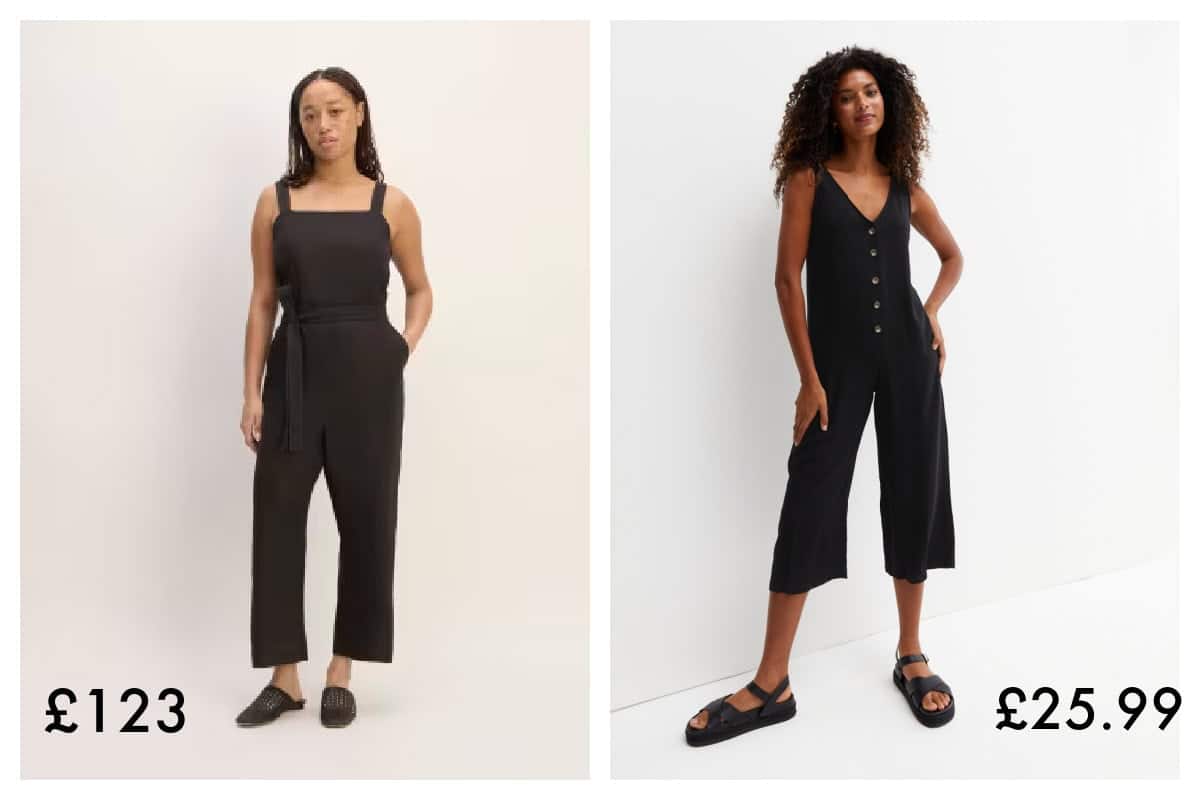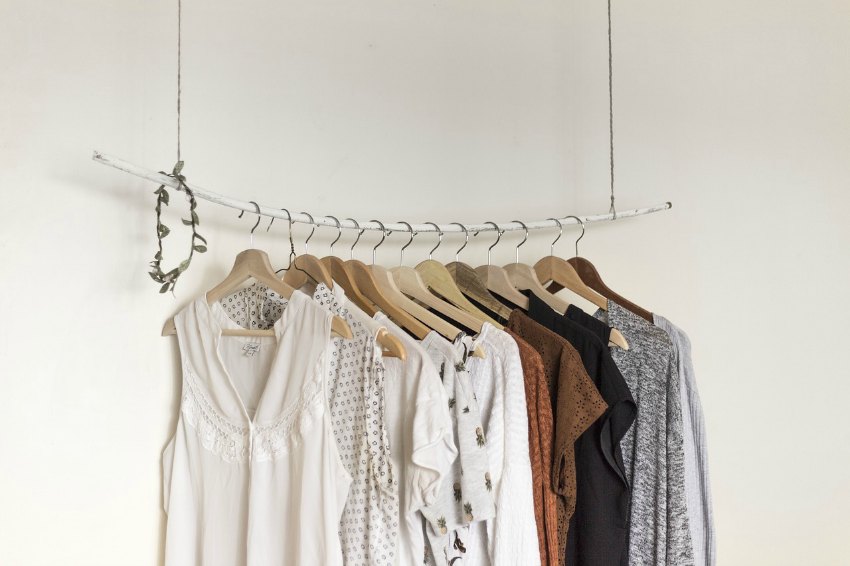Why Is Ethical Clothing Expensive Compared to Fast Fashion?
To support the running costs of Moral Fibres, this post contains affiliate links. This means Moral Fibres may earn a small commission, at no extra cost to readers, on items purchased through these links.
Have you ever wondered why is ethical clothing expensive? I would argue that we’re asking the wrong question. Shouldn’t we be asking why is fast fashion so cheap?
I often hear people express a desire to shop more ethically, but they hesitate because ethical clothing seems out of reach financially. I understand that perspective. When finances are tight, it’s natural to want to stretch your budget as far as possible. But is ethical clothing truly expensive? Let’s explore this further.
Is Ethical Clothing Expensive?

Is ethical clothing expensive though? When you look at it on the surface, yes, ethical clothing is expensive.
The £123 linen jumpsuit on the left is made by Everlane, whose business model is based on ‘radical transparency’ (but apparently not THE most ethical of options). It is pretty similar to the £25.99 jumpsuit on the right from a well-known UK fast fashion brand.
However, the actual cost of something takes a lot more than just a quick glance at the price tag. When you really think about the £25.99 jumpsuit, you begin to wonder how manufacturers can possibly make an item for £25.99, and still make a profit.
What Goes Into Making Clothing?
If you’ve ever tried to make your own clothing you’ll know it’s impossible to make an item of clothing for that amount of money. First, you’ve got to buy the fabric (surprisingly expensive), and the pattern, as well as any thread, zips, buttons or other embellishments you need. Then there’s the electricity to power your sewing machine, as well as any ongoing maintenance costs of your machine.
By the time you’ve got to that stage, you’ve probably exceeded £25.99. And that’s before you’ve even accounted for the cost of your own time, the cost of the space to make the clothes, the initial outlay on your sewing machine, and well as your time in building up your sewing skills.
If you then tried to sell your item to a shop to sell, the shop would then need to put a markup on the item to be able to make a profit. If a brand is making a profit on a £25.99 item of clothing, then you’ve got to wonder what was actually paid to the factory making it and the staff making the clothes.
Rather than saying that ethical clothing is expensive, I would argue that the rise of fast fashion retailers has caused us to lose our sense of perspective, and our benchmarks and baselines on what is expensive. I would say that instead, we need to ask why fast fashion is so cheap.
The Fast Fashion Problem
Why is fast fashion so cheap? Ultimately, it’s because someone, somewhere in the Global South is paying the price for us to be able to access such cheap clothing. Fast fashion garment workers often face the following non-exhaustive issues:
- Poverty wages
- Long hours
- Forced labour
- Lack of workers’ rights
- Unhealthy and dangerous working conditions
- Child labour
The planet is also paying the price for our fast fashion addiction. From resource depletion, pollution and waste generation, the earth is struggling to cope with the volume of clothing the fast fashion industry pumps out. If fast fashion industries had to pay the cost of cleaning up after themselves, fashion would cost a whole lot more.
Extra Costs Faced By Sustainable Brands
Ethical fashion brands on the other hand have various additional costs that fast fashion brands don’t. This can include:
- Eco-Friendly Materials – Most ethical brands often use organic, sustainable, or eco-friendly materials, which can be more expensive to source and produce than the cheaper, conventional materials favoured by fast fashion companies.
- Fair Wages and Working Conditions – Ethical fashion ensures fair wages and safe working conditions for garment workers. This means paying workers living wages, providing benefits, and ensuring their safety, which adds to production costs.
- Increased Transparency – Ethical fashion brands are often transparent about their supply chains, ensuring that workers are treated ethically throughout the production process. This transparency requires additional resources for monitoring and accountability.
- Sustainable Practices – Ethical fashion brands prioritise sustainability at every stage of production, from sourcing materials to manufacturing and distribution. This might involve using renewable energy, reducing water usage, minimising waste, and investing in eco-friendly packaging, all of which incur additional costs.
- Small-Scale Production – Many ethical fashion brands operate on a smaller scale compared to fast fashion brands. This means they don’t benefit from the same economies of scale, leading to higher production costs per unit.
- Certification: Some ethical fashion brands are certified as organic, fair trade, or a BCorp, to help show customers they aren’t greenwashing. Certification can come at a substantial cost to a brand, and add to the overall cost of production.
Fast Fashion Deflation
One of the main reasons why our perceptions are skewed when it comes to the real cost of clothing has been the declining costs of clothing.
Since the 1980’s the cost of housing, rent, food, fuel and other consumables has risen, in some cases dramatically. In 1980 the average cost of a home was £23,000 (around £123,600 in today’s money). Whilst by the end of 2023, the average price of a home was £260,000 according to the same report. Food items have also increased in price over the same period, often by more than 300%.
It goes without saying then that you would expect to go into a shop and buy an item of clothing that was considerably more expensive now than it was in 1980. When it comes to fast fashion this is no longer the case.
Why Has Clothing Decreased In Price?
What has actually happened with clothing is that since the 1980s, instead of rising in price in line with inflation, clothes prices have fallen. In fact, they’ve fallen to the point we’re at now where brand new items of clothing can be bought for just £1.
Prior to the 1980’s the majority of clothing was made domestically. I’ve struggled to find UK-based data, but the New York Times reported in 2009 that in the 1960s, the United States made 98% of its shoes. By 2009 it was a completely different picture, with the US importing more than 90% of its footwear. This is more than likely mirrored in clothing manufacturing too.
The reason for this outsourcing is that in the 1980s clothing manufacturers realised they could manufacture abroad. Particularly in places where they could pay workers considerably less, and where workers could work longer hours in poorer conditions. This ultimately meant greater profits for manufacturers and lower prices for consumers.
Driving Down The Value of Clothing

We’re now so used to cheap clothes that have flooded the market since the 1980’s, that this has artificially driven down the value of clothing.
If you’re in your forties or younger you’ll have grown up in an age where clothing has gotten cheaper and cheaper. You won’t, or will barely remember a time when clothing wasn’t cheap. Yet going back to the £123 jumpsuit, I suspect that this is more like what the average item of clothing should cost in 2024, if not more. Is ethical clothing expensive then? I’m inclined to say no.
The Impact On Household Spending
It’s also quite clear the impact that the mass production of clothing overseas has had on household spending. Between 1957 and 2018, the percentage of the average UK household’s annual income that was spent on clothing halved from 10% to 5%.
This is despite the fact that we buy more clothes than ever before. The average consumer buys 60% more pieces of clothing than they did in the year 2000.
More worryingly, another report suggests the average item of clothing is worn just seven times before being discarded, while across the UK 1.6 billion unworn items of clothing are banished to the back of our wardrobes. Cheaper prices mean consumers value their clothes less, meaning they buy more and more clothes. When clothing is viewed as disposable, consumers see ethical clothing as being prohibitively expensive.
What’s The Answer?
So what’s the answer to ethical clothing seeming prohibitively expensive? The answer is, I think, in several parts:
Changing Our Relationship With Clothing
I think part of the answer lies in our relationship with clothing. Buying far fewer items of clothing is key. Learning to love the items of clothing we do have, and looking after them by washing them well, and repairing them when they need it is a huge part of the ethical clothing equation that almost anyone, regardless of the size of their disposable income, can be a part of.
Another is not buying into trends. Instead, buy ethical clothing that you want to wear time and again. I’ve written in length about these aspects of consumerism – but in a nutshell, when you factor in the cost per wear of an item that won’t date in a few months, you do start to change your views on ethical clothing being better value rather than expensive.
Another part of it voting with your wallet. If more and more people shop with more responsible and ethical clothing retailers then this sends a clear message to fast-fashion retailers that they have to up their game and make their clothes more ethically.
Embrace Preloved Fashion
Can’t afford to shop from ethical brands? You don’t have to turn to fast fashion to find what you need. Shopping secondhand is the single most affordable and ethical way to buy the clothes you need. You don’t even need to trawl your local charity shops searching for the perfect piece. There are heaps of ways to pick up preloved pieces online.
Shift Your Mindset
It’s easy to write off all ethical fashion as being expensive. However, many sustainable brands are, price-wise, on par with high-street fashion stores such as Zara. Try my guide to affordable ethical clothing brands to be pleasantly surprised.
Influencers Need To Act More Responsibly
People with influence also have to act more responsibly. YouTube haul videos with vloggers with huge followings boasting to impressionable young viewers about how many cheap items of clothing they’ve bought only perpetuate the cheap disposable clothing myth. Meanwhile, celebrities who are used to greenwash unsustainable brands are part of this problem too.
Supporting Ethical Fashion Isn’t Just About What We Buy
It’s also really important to remember that supporting ethical fashion doesn’t just have to mean buying ethical fashion. There are lots of ways to support ethical fashion without spending money. This includes supporting garment workers’ rights to calling out greenwashing from big brands.
The Bottom Line
Ethical fashion isn’t expensive – fast fashion has just distorted our thinking about the real cost of clothing. Perhaps we have to work on regaining our sense of perspective when it comes to the cost of clothes. Spending more on each individual item of clothing we buy and spending better, but buying far fewer items of clothing is the only way to re-establish sensible baselines.
Found this post useful? Please consider buying me a virtual coffee to help support the site’s running costs.




